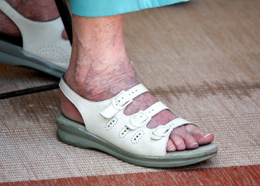Phlebitis

What is phlebitis?
Phlebitis is the inflammation of a vein. It can occur in veins on the surface of the skin (also called superficial phlebitis), in varicose veins, and in deeper veins, typically those in a person’s legs. Blood clots can form in the inflamed area (thrombophlebitis), and when these occur in deep veins, a potentially life-threatening condition known as deep vein thrombophlebitis can develop.
What are the symptoms of phlebitis?
Symptoms depend on the location of the inflammation. Superficial phlebitis can cause symptoms such as:
- Redness along the path of the vein
- Warmth, tenderness, or swelling in affected area
- Itching or burning in affected area
- Low-grade fever.
These symptoms may feel worse when the affected area (such as a leg) is lowered, particularly in the morning. Superficial phlebitis is uncomfortable but rarely serious. If clotting occurs, the inflamed vein will feel like a hard string or cord under the skin, and won’t collapse like a normal varicose vein.
Deep vein thrombophlebitis often causes no symptoms at all. When it does, symptoms include warmth, redness, and swelling in the affected limb. Deep vein thrombophlebitis is dangerous because the blood clot lodged in the vein (called a deep venous thrombosis or DVT) can break free and travel to a person’s lungs, a situation that is often fatal. Chest pain and shortness of breath are early signs that this has occurred.
What are the causes?
Superficial phlebitis often has no clear cause. It can sometimes occur after a medical procedure, such as the insertion of an intravenous (IV) line. It can also be caused from minor injuries to existing varicose veins. Causes of deep vein thrombosis (DVT) include:
- Prolonged inactivity, such as sitting in a car or plane for long periods of time or lying in bed after surgery
- Paralysis, which leads to inactivity
- Some types of cancer
- Use of the hormone estrogen
- Genetics
- Injury to the vein’s inner lining
- Clotting disorders
- Any condition which slows blood flow.
Who is likely to develop phlebitis?
People who are at higher risk of deep vein thrombosis include those who:
- Are obese
- Smoke
- Are sedentary or inactive for long periods of time
- Are pregnant
- Use hormone replacement drugs or birth control pills
- Have had an injury to their arm or leg
- Have a family history of blood clots.
How is phlebitis diagnosed?
Superficial phlebitis is usually diagnosed with a simple physical examination. Tests used to diagnose deep vein thrombosis (DVT) include:
- Ultrasound
- CT scan
- MRI scan
- Blood tests
What is the conventional treatment?
For superficial phlebitis, self care measures can help relieve symptoms. Conventional treatment usually involves elevating the affected limb and applying warm compresses to ease discomfort. Compression stockings and over-the-counter anti-inflammatory drugs such as ibuprofen may also help alleviate pain. For thrombophlebitis, the clot may be removed with a minor surgical procedure, followed by wearing compression bandages.
Deep vein thrombosis (DVT) requires medical attention. Physicians treat it with anticoagulant drugs (“blood thinners”) that can help prevent blood clots. An anticoagulant called heparin is first injected to stop the clot from growing, then the patient must take Coumadin (warfarin), an oral anticoagulant, for several months afterward. A surgical procedure called angioplasty is sometimes needed to remove a clot, and a “clot filter” is sometimes surgically inserted to keep clots and parts of clots from reaching the lungs. People with deep vein thrombosis should also use compression stockings to prevent swelling.
What therapies does Dr. Weil recommend for phlebitis?
Along with the conventional therapies listed above, Dr. Weil recommends the following for general vein and circulatory health:
- The best prevention is exercising regularly to maintain and improve the strength of the circulatory system and blood vessels. Walking is ideal.
- Lose weight or maintain ideal weight.
- Follow a low salt, high fiber diet, such as the anti-inflammatory diet..
- Avoid either sitting or standing for long periods of time, and try to elevate your legs when resting. If you have to stand or sit for a long time, wear elastic support stockings.
- As a preventive measure, try horse chestnut, an herbal extract that supports small vessel health and reduces swelling. It comes in an oral form and as a topical cream.
Use antioxidants called oligomeric proanthocyanidins, or OPCs, extracted from grape seeds or pine bark. These compounds are nontoxic free radical scavengers that help support blood vessel integrity.









